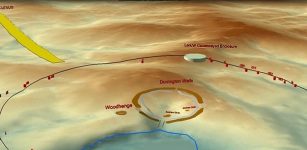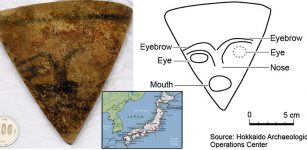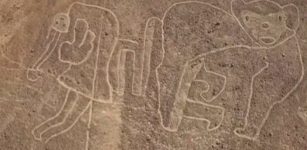Huge Ancient Animal Sculptures Made By Unknown Carvers At Camel Site In Saudi Arabia Puzzle Archaeologists
AncientPages.com - Who made these remarkable huge animal sculptures? What tools did our ancestors use? Could this be the work of an ancient lost Sahara civilization?
Located at the Camel site in Saudi Arabia, these ancient carving are exceptional by their size and artistic quality, but there is no information about the ancient civilization that made these fantastic rock reliefs.
Aerial view of the Camel Site, and the locations of each sculpture. Credit: G. Charloux et al., 2018
The sculptures can be found in northern Saudi Arabian province of Al-Jawf, about 8 km north of the city of Sakaka. The the long-forgotten and damaged reliefs have escaped the world's attention, but they will now be examined in more detail by a team of scientists from the French National Center for Scientific Research (CNRS) The team started to study these rock carvings in 2016 and continued in 2017
The goal is now to find out who these mysterious ancient carvers were.
Rock carving depicting a large camel. Credit: G. Charloux et al., 2018
Researchers speculate the ancient cavers may have been influenced by the craftsmanship of the then neighboring Nabataean and Parthian populations, as the rocks lie in the vicinity of several Nabataean sites and the carvings bear strong resemblance with the camel caravan featured in the Siq of Petra. Scientists also point out the animal sculptures remind of Mesopotamian art, especially that of Hatra, an ancient city that now lies in the north of Iraq.
Interestingly, it worth noting that as Ancient Pages reported earlier, amazing, gigantic engravings of a giraffe can be found in the heart of what is now the Tenere (Ténéré desert), in northern Niger, one of the Sahara’s most desolate regions.
Could there be a connection between these huge ancient animal carvings?
Gigantic Engravings Of A Giraffe Created Long Before Egypt As We Know It Existed - Read more
The age of the animal carvings in Saudi Arabia is unknown. The absence of tool marks, wiped away by erosion, or of known engraving artifacts such as picks and burins in the surroundings also prevents accurate dating. "Apart from the flint found nearby, we have no diagnostic material, and we are not sure whether these tools were used to carve the sculptures," Guillaume Charloux, of the CNRS Orient & Méditerranée joint research unit said.
 Animal scene: Credit: G. Charloux et al., 2018
Animal scene: Credit: G. Charloux et al., 2018
In addition, the rocks bear no inscriptions, further adding to the enigma. There are also no signs of human presence in the desertic landscape around Camel Site. “The Nabataeans were strongly implanted in the area, and could have had a community nearby. They also traded with Mesopotamia, which suggests the spurs may have been a milestone on an ancient caravan route," Charloux explains.
 Camel head - Credit: G. Charloux et al., 2018
Camel head - Credit: G. Charloux et al., 2018
See also:
Thousands Unknown Ancient Structures Seen From Space: Puzzling Aerial Archaeology In The Middle East
The purpose of the animal carvings remains unknown. Maybe this was an ancient site of worship.
There are a number of things we don't know about this enigmatic place and it's obvious scientists have encountered a true archaeological mystery.
Charloux thinks it will take a long time to reveal the truth about the animal sculptures at the Camel site. However, on think is certain - the carvers were talented artists.
The originality of the themes chosen and techniques employed, suggest they could have local to the area. People who made these wonderful carvings, showed surprising mastery and sense of aesthetics.
AncientPages.com
Expand for references






















